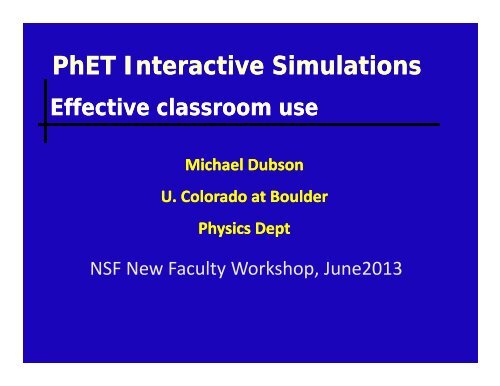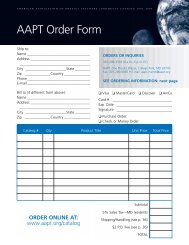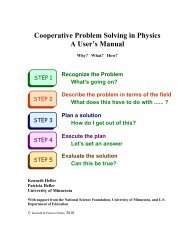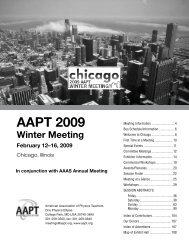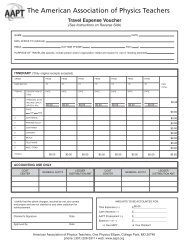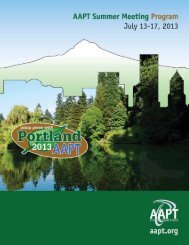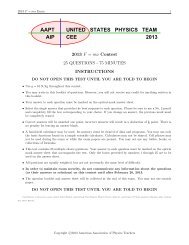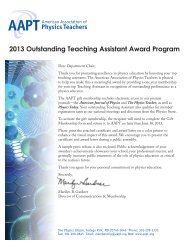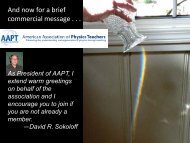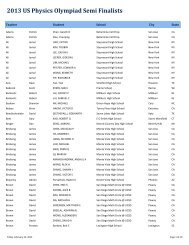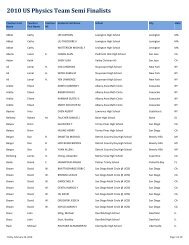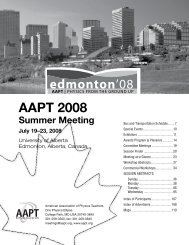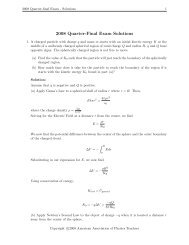PhET Interactive Simulations:Effective Classroom Use - Michael ...
PhET Interactive Simulations:Effective Classroom Use - Michael ...
PhET Interactive Simulations:Effective Classroom Use - Michael ...
You also want an ePaper? Increase the reach of your titles
YUMPU automatically turns print PDFs into web optimized ePapers that Google loves.
<strong>PhET</strong> <strong>Interactive</strong> <strong>Simulations</strong><br />
<strong>Effective</strong> classroom use<br />
<strong>Michael</strong> Dubson<br />
U. Colorado at Boulder<br />
Physics Dept<br />
NSF New Faculty Workshop, June2013
What is <strong>PhET</strong><br />
Originally, the Physics Education Technology project.<br />
• Suite of >100 interactive sims for science education.<br />
• Research-based and user-tested.<br />
• Java and Flash, run in browser or offline.<br />
• Physics, Math, Chemistry, Earth Science, Biology.<br />
• All FREE. Source code available.
Where is <strong>PhET</strong><br />
http://phet.colorado.edu
Examples:<br />
• Circuit Construction kit.<br />
• Masses and Springs.
Who is <strong>PhET</strong><br />
Founded by Carl Wieman, 2002<br />
Part of the Physics Education Research Group at CU Boulder<br />
University faculty, post-docs,<br />
K-12 teachers, software developers<br />
Prof. Kathy Perkins, CEO, education researcher, and<br />
grant-getter extraordinaire
Accessible<br />
• Open-use License: Creative Commons - Attribution<br />
• Easy to translate for World-wide <strong>Use</strong>:<br />
Over 2700 translations in 59 languages,<br />
34% of use outside US<br />
• >40 million sims run last year, exponential growth
<strong>PhET</strong> around the world<br />
Serbia<br />
Brazil<br />
Vietnam<br />
Uganda
What is <strong>PhET</strong>’s intended audience<br />
• Originally, college freshmen, physics sims<br />
• Now, grade school through grad school<br />
sims are physics and math,<br />
many chemistry, some earth science and biology<br />
Arithmetic<br />
Workout<br />
QM Tunneling<br />
Build an Atom<br />
Normal Modes
How might you use these sims<br />
in your school
Designed for versatile use<br />
• Pre-lecture assignment<br />
• <strong>Interactive</strong> Lecture Demonstration<br />
• Clicker Questions<br />
• In-class activity<br />
• Lab or Recitation<br />
• Homework<br />
No silver bullet: context and activity critical
Versatile! Make easy to use<br />
‣ Flexibility for you to<br />
<br />
<br />
<br />
Pick and choose which sims to use<br />
Customize use …<br />
to your environment and your learning goal<br />
Search database of activities (>500 by <strong>PhET</strong> or Teacher-users)<br />
Circuit Construction Kit<br />
CCK in grade school:<br />
“Make the light bulb light”<br />
CCK in college:<br />
“Explain why the light dims<br />
when you turn the heater on”
Examples:<br />
• Friction<br />
• Energy Skate Park
Example: Concept Tests<br />
I move the zero of PE up to the starting point of the<br />
Skateboarder (skateboarder still starts from rest).<br />
The total energy of the system is now:<br />
A) Zero B) positive C) negative<br />
D) Depends on the position of the skateboarder
In the circuit, what happens to the brightness of bulb 1, when<br />
bulb 2 burns out (When a bulb burns out, its resistance<br />
becomes infinite.)<br />
A) Bulb 1 gets brighter<br />
B) Bulb 1 gets dimmer.<br />
C) Its brightness remains the same.<br />
(Hint: What happens to the current from the battery when<br />
bulb 2 burns out.)
If we increase the error bar on the date point shown, what<br />
happens to the slope of the best-fit line<br />
A) It becomes more negative (line tilts CW).<br />
B) It becomes less negative (line tilts CCW).<br />
C) It does not change.
Why is <strong>PhET</strong> successful<br />
• Diverse design team<br />
• <strong>Use</strong>r interviews<br />
• <strong>Classroom</strong> testing<br />
• Research-based
Design Philosophy<br />
• Inviting, intuitive interface, usable without instructions<br />
• Highly interactive: instant animated feedback as students explore<br />
• Accurate, dynamic visual representations; show the invisible<br />
• Allow actions that would be difficult or impossible in the real world<br />
• Game-like environment<br />
• Interface design that implicitly scaffolds inquiry
Research-Based Design supports inquiry-learning<br />
<strong>Use</strong> accurate, dynamic<br />
visual representations<br />
Show the invisibleisible<br />
Create a game-like<br />
environment<br />
Make simulations highly<br />
interactive<br />
Provide real-time,<br />
animated feedback<br />
as students play<br />
Implicitly scaffold<br />
inquiry through design<br />
of controls and<br />
representations<br />
Allow actions that would be<br />
difficult or impossible in the<br />
real world<br />
Provide an intuitive<br />
interface, usable<br />
without instructions
<strong>PhET</strong> Design Process<br />
2 – 12 months, ≈$50K/sim$ /<br />
Initial design<br />
Final design<br />
Research<br />
Interviews<br />
<strong>Classroom</strong>s<br />
Redesign
Your thoughts…<br />
Compare these tools:
<strong>PhET</strong> in popular culture
Can <strong>PhET</strong> sims replace real equipment<br />
• They can, but we don’t think they should.<br />
• Meant to compliment, not replace with lab equipment.<br />
• Sims lack real-world “dirt” effects, allow students to focus on<br />
physics concepts.<br />
Circuit Construction Kit vs. real circuits<br />
“When learning about the real world is better done virtually.. “, N.D. Finkelstein<br />
et al., Phys. Rev. ST Phys. Educ. Res. 1, 010103, 2005.<br />
Students who only used virtual circuits, did equally well on<br />
building real circuits final.<br />
Sims allow risk-free<br />
Sims allow risk-free,<br />
rapid inquiry cycle.
Do students learn if I just tell them to<br />
play with a sim<br />
• Seldom. Guided inquiry essential.<br />
• Large data-base of classroom-tested<br />
activities available on the <strong>PhET</strong> site.<br />
What makes a good sim activity<br />
• Minimum instruction.<br />
Detailed procedures inhibit student exploration.<br />
• Clear Learning Goals<br />
Give students the goal, not the procedure.
Worse:<br />
In-Class activity or Lab<br />
Better:<br />
• Give directions on how to use<br />
• Provide activity and do not<br />
the sim<br />
offer any pointers on the sim<br />
itself<br />
• Result: Students are<br />
nervous, reluctant to try<br />
things, ask lots of<br />
questions about sim use,<br />
not learning goals.<br />
• Result: Students explore<br />
uninhibitedly, quickly<br />
find/learn all the<br />
controls, become the<br />
“owner” of the sim.
Example Activity: Masses and Springs<br />
• 5-10 minutes of play – No instructions.<br />
• Challenge 1:Using data from the sim, make a<br />
graph that shows whether or not the springs<br />
obey Hooke’s Law.<br />
• Challenge 2: What is the mass of the red<br />
weight<br />
• Challenge 3: Determine the spring constant in<br />
two different ways: with your graph from (1)<br />
and with the stopwatch.
Cookbook directions (NOT effective):<br />
• Watch me while I show you the controls.<br />
• Measure the equilibrium extension of spring<br />
1, for each of the 3 different known masses,<br />
and make a graph of stretch of the spring (on<br />
y-axis) vs. mass (on x-axis). From this,<br />
determine the spring constant k of the spring.<br />
Recall that F spring = −kx, where x is the stretch<br />
of the spring. Don’t forget that weight is mg,<br />
where g = 9.8 m/s 2 .
What would you like to see in <strong>PhET</strong><br />
• Sim ideas New features <br />
Door Prize! : You can see NEW sims in<br />
development, before they are published, at<br />
http://www.colorad.edu/physics/phet/dev
The Future…<br />
• More sims<br />
• Compatibility with iPad<br />
• <strong>Classroom</strong> sim sharing
How can you contribute<br />
Report bugs<br />
Send us your ideas<br />
for new sims!<br />
Email: phethelp@colorado.edu
How can <strong>PhET</strong> be free<br />
Current budget > $1M / year<br />
NSF<br />
Hewlett Foundation<br />
The O’Donnell Foundation<br />
King Saud University<br />
University of Colorado<br />
Carl Wieman & Sarah Gilbert
How can <strong>PhET</strong> stay free<br />
• We’re not sure.<br />
• Major funding from grants not sustainable.<br />
• Seeking corporate sponsors, large and small<br />
donors.<br />
• Your advise or $$ gratefully accepted.
<strong>PhET</strong> <strong>Interactive</strong> <strong>Simulations</strong><br />
• Suite of >100 interactive simulations<br />
• Physics , Chemistry , Math<br />
Expanding into biology, earth science<br />
• Research-based and user-tested<br />
• Free! Online or downloadable. d (~130 MB)<br />
• Easy to use and incorporate in class<br />
http://phet.colorado.edu
Extra Slides Follow
Designing Activities:<br />
What do students learn<br />
in each activity<br />
Add 100 silver<br />
bromide pairs to the<br />
water. How many<br />
silver and bromide<br />
ions dissolve in the<br />
water Repeat this<br />
for all salts.<br />
Investigate different<br />
salts. What features<br />
do salts have in<br />
common, and how do<br />
salts differ from each<br />
other
Old Acid-Base Solutions
New Acid-Base Solutions<br />
Why is this sim better
Interview Study:<br />
Type of Guidance<br />
Compared dtwo types of guidance<br />
Examined Student Behavior<br />
Open Conceptual<br />
Questions +<br />
Guided Activity<br />
In the “Bar Magnet” tab,<br />
identify all controls, …<br />
What does the<br />
“Strength” slider do<br />
Open Conceptual<br />
Questions<br />
Free exploration<br />
of sim
Results<br />
Guided Activity<br />
Student Mode:<br />
Students answer question<br />
and wait for the next.<br />
“OK, continue”<br />
“Is that sufficient for step 2<br />
Often don’t tie pieces<br />
together.<br />
Open Conceptual<br />
Questions<br />
Scientist-like Exploration:<br />
Explore via their own<br />
questioning<br />
i<br />
“Oh, I wasn’t expecting that”<br />
“I was looking around to see<br />
if it was an effect of having<br />
more wires.”
What did students explore<br />
12 features not mentioned in the Cookbook activity:<br />
Open Q’s<br />
Cookbook<br />
Explored<br />
Just noticed<br />
Not noticed


